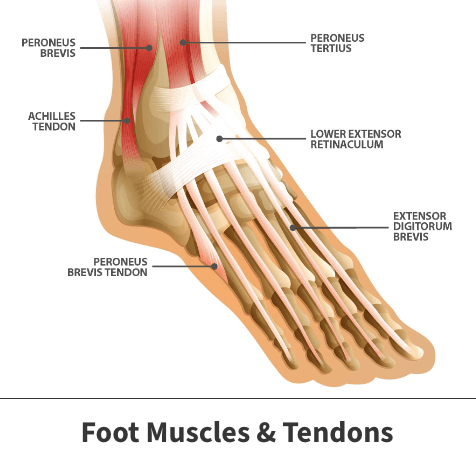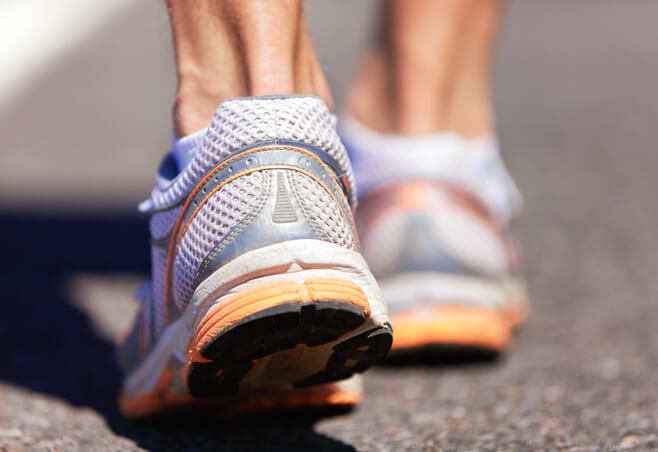Tear in the Achilles tendon
An Achilles tendon rupture is when a tear in the Achilles tendon occurs. This tear usually occurs when sudden, extreme stress is applied to the tendon, causing it to tear. The tear can be either partial or complete, and can be treated surgically or non-surgically, depending on the severity of the tear. Both treatment types need to be paired with physical therapy exercises to return to former activity levels.
Anatomy

The Achilles tendon, also known as the calcaneal tendon, is a tough, fibrous band of tissue that connects the calf muscle to the heel bone (calcaneus). When the calf muscles flex, the Achilles tendon pulls on the heel, allowing us to walk, run, climb stairs, jump, and stand on the tip of your toes. It is both the strongest and largest tendon in the entire body. While it may be the strongest, it is also vulnerable to injury, due to the high tensions placed on it and its limited blood supply. The tearing of the Achilles tendon is when the tendon tears, resulting in the separation of the tendon fibers. When this occurs, the tendon can no longer perform its normal function.
About
An Achilles tendon rupture is when the Achilles tendon is torn. The tear may be either partial or complete. In the case of a partial tear, the tendon is partially torn but still joined to the calf muscle. During a complete tear, the connection between the calf muscle and the ankle bone is completely lost. Ruptures are often caused by a sudden increase in stress on the Achilles tendon, such as falling from a height, the intensity of sports, or falling into a hole.
While an Achilles tendon rupture can happen to anyone, certain factors increase the likelihood of experiencing the injury:
- Age – The peak age for a torn Achilles tendon is 30 to 40.
- Sex – Men are up to five times more likely to experience an Achilles tendon rupture than women.
- Recreational sports – People who take part in recreational sports, specifically ones that involve running, jumping, and sudden starts and stops, have an increased chance of experiencing an Achilles tendon rupture.
- Steroid injections – Doctors sometimes inject steroids into an ankle joint to reduce pain and inflammation. This medication can weaken nearby tendons and has been associated with Achilles tendon ruptures.
- Certain antibiotics – Fluoroquinolone antibiotics, such as levofloxacin (Levaquin) or ciprofloxacin (Cipro), increase the risk of Achilles tendon ruptures.
- Obesity – Excess weight puts more strain on the tendon.

Symptoms
While it is possible to experience no symptoms with an Achilles tendon rupture, most people experience the following:
- The feeling of having been kicked in the calf
- Pain (possibly severe)
- Swelling near the heel
- Inability to bend the foot downward or “push off” the injured leg when walking
- Inability to stand on the toes of the injured leg
- Popping or snapping sound during the moment of injury
Diagnosis
Your Florida Orthopaedic Institute physician will look at your lower leg for tenderness, swelling, and a possible gap in your tendon if it has ruptured completely. Your physician may also squeeze your calf muscle to see if it will automatically flex. If it does not, there is a high chance your Achilles tendon has ruptured. If these tests do not accurately depict whether the tendon has torn partially or completely, then an MRI or ultrasound may be ordered. Both of these tests create images of the tissues of your body and show the tendon.
Treatment
Both surgical and nonsurgical treatments are available for the repair of an Achilles tendon rupture. While surgery is often performed to repair the rupture, nonsurgical options work well for less severe cases.
Nonsurgical treatments
Nonsurgical treatments generally include:
- Resting the tendon by using crutches
- Icing the area
- Pain relievers
- Preventing the ankle from moving for the first few weeks usually with the use of a walking boot with heel wedges or a cast with the foot flexed down
While nonsurgical options avoid the risks associated with surgery, such as infection, a nonsurgical approach may increase your chances of re-rupture. Additionally, a full recovery may take longer to achieve with nonsurgical treatments.
Surgical procedures and treatments
The surgical procedure generally involves making an incision in the back of the lower leg and stitching the torn tendon together. Depending on the severity of the rupture, the repair might be reinforced with other tendons, usually ones from other parts of the foot. Patients are generally released from the hospital the day of surgery.
This surgery should not be performed on a patient with an active infection or unhealthy skin at or around the site of the Achilles tendon rupture, or if they are not healthy enough to undergo surgery.
Recovery
After either a surgical or nonsurgical approach, physical therapy exercises will be required to strengthen the leg muscles and the Achilles tendon. Most people return to their former level of activity within four to six months. It is important to continue strength and stability training afterwards because some problems can persist for up to a year. Currently, rehabilitation after either surgical or nonsurgical treatments is progressing to be done earlier. Studies are ongoing in this area to determine its safety and effectiveness.
Videos
Related specialties
- Achilles Calcific Tendinitis
- Achilles Tendonitis
- Ankle Fracture Surgery
- Ankle Fractures (Broken Ankle)
- Ankle Fusion Surgery
- Arthroscopic Articular Cartilage Repair
- Arthroscopy of the Ankle
- Bunions
- Charcot Joint
- Common Foot Fractures in Athletes
- Foot Stress Fractures
- Hallux Rigidus Surgery - Cheilectomy
- Hammer Toe
- High Ankle Sprain (Syndesmosis Ligament Injury)
- Intraarticular Calcaneal Fracture
- Lisfranc Injuries
- Mallet, Hammer & Claw Toes
- Metatarsalgia
- Neuromas (Foot)
- Plantar Fasciitis
- Sprained Ankle
- Total Ankle Replacement
- Turf Toe
